



We are building CultureStake, the world’s first collective cultural decision making app (using Quadratic Voting on the blockchain) because we want to enable all communities to choose the creative experiences they want to have in their own areas. The original idea was driven by an awareness that top down arts programming is increasingly problematic. We wanted to find a way to give more people more of a say in what art and culture gets produced in their neighbourhoods – and more opportunity to be the co-creators. In a nutshell, our mission is to put the public at the heart of public arts.
Communities
We want communities to explore and learn together what we all want to experience in our localities. For example how might a theatre audience cast a play differently or a park community curate a public art exhibition?
Cultural Organisations
We want deeper, richer and more open consultation with the communities cultural organisations work for. For example, how might a city council find out which new artwork should occupy a recently vacated public plinth. Or how might an arts organisation discover which artist on their shortlist should be next summer’s blockbuster?
For Everyone
We want a data commons that widens the conversation about how art is valued by different communities around the world. For example, how might our ideas about culture change if we can see what’s important to other people?
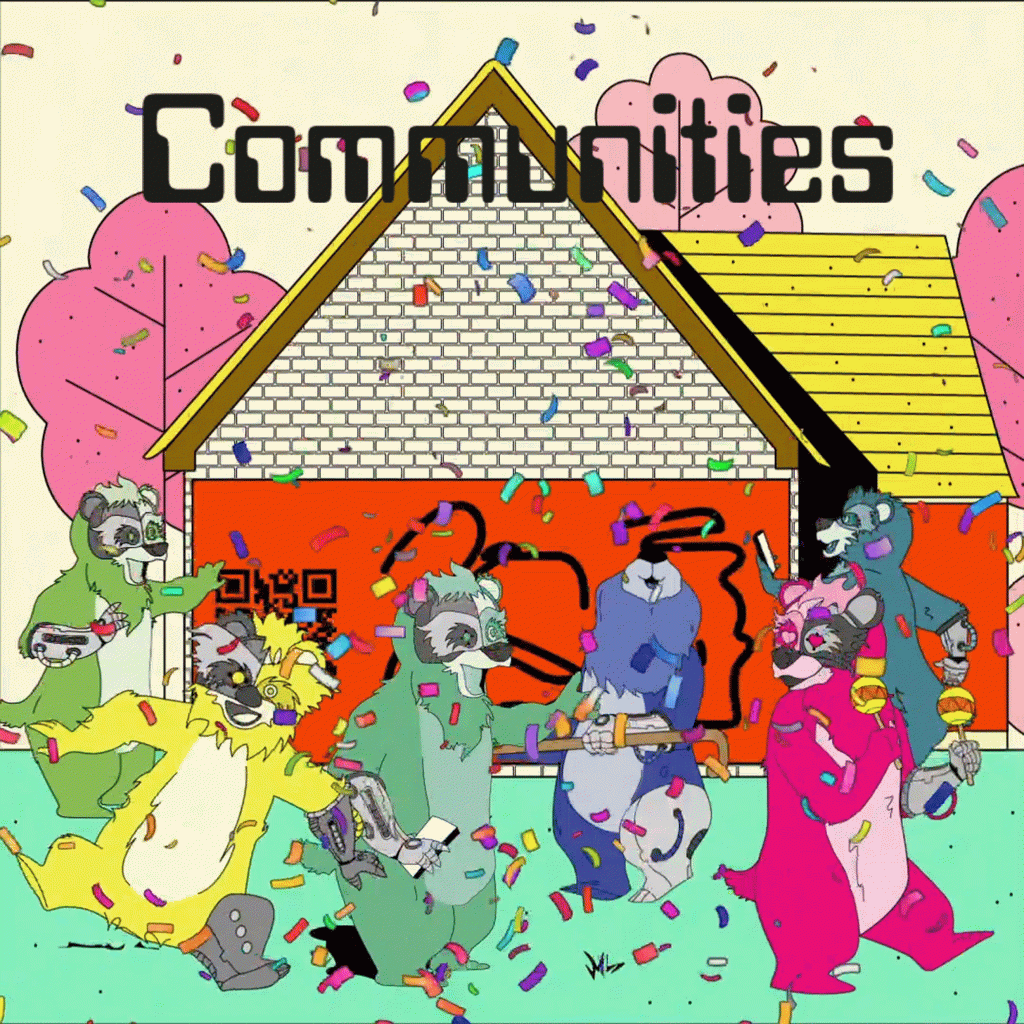
We are using Quadratic Voting because it takes us all from confusing numbers to nuanced feelings.
In QV voters receive a number of ‘vibe credits’ which they can allocate to different creative proposals to express their support. The quadratic function means that showing a strong preference comes at a credit cost. Or rather:
This means that QV is quite unlike any other voting process. Indeed, unlike a one person one vote system, in QV votes express not just what we care about but how much we care! This matters because one person one vote systems usually don’t present the reason why someone voted the way they did or how strongly they felt about it. Politics have taught us not to trust the way votes are interpreted. Voters’ intentions are often misrepresented and communities are polarised about the limited information. Whereas QV allows us to express the intensity of our convictions, giving each of us:
Plus we’ve designed CultureStake so vote organisers can weight the votes of those closest to the issues that matter. For example, in our use of CultureStake for the People’s Park Plinth, any votes cast inside Finsbury Park mean more overall. So those most affected get more of a say.
And we run all CultureStake votes on the blockchain because the blockchain is like a big indelible ledger. This means that a vote cannot be rigged and is always stored extra safely so what we can promise voters is that they can trust our system.
There are many ways to run a CultureStake vote. A theatre could develop an unfinished performance and ask communities to choose the next steps. An arts organisation might offer up a range of different events and invite communities to choose what they want to encounter. Either way, the voting system doesn’t rely on asking everyone to just pick their favourite, but rather explore their thoughts and feelings in relation to a set of questions. So the result is always knowing more about what communities think and feel. Plus, we never show what ranked 1st, 2nd, or 3rd, but rather what was selected and what thoughts and opinions drove people’s selections.
At Furtherfield we are using CultureStake to power our People’s Park Plinth initiative in Finsbury Park. The concept behind the People’s Park Plinth is that our Finsbury Park buildings and even the park itself will act as a plinth for public digital artworks chosen by our communities using our CultureStake app.
The Gallery building will therefore provide an interface where people can scan hoardings to access works which offer a range of XR-enabled experiences in the park. Annually there will be a set of ‘proposal’ artworks, which will give people a first glimpse at what can be created more fully later in the year. Everyone will have time to explore these proposals and then use CutlureStake to choose what they want.
In our pilot year we tripled local engagement and received amazing local feedback like this:
“I live nearby and I’ve been talking about this with my friends for months, it’s such a great idea, to give people a say!”
“[…]decentralisation allows people to have slower but more grassroots-based management of any decision making.”
“I think it’s good that we have a say as well. And I really love voting.”
“Usually I guess I choose art by going to a place and supporting it like that but I’ve never been involved so much in really deciding on what I will see next. And yeah it makes me actually feel good too.”
“[…] quite a lot of times actually […] art is reserved only for the higher echelons of society and I feel like this is really nice that anyone can come in and you vote for who you like or what art you like.”
“I do feel represented…”
We are now in the next phase of development and are actively looking for partners from different types of venues and communities to partner with us so we can explore their unique needs and ensure we have a robust system.
If you are a small, medium, large, networked, physical, touring, online or any other type of cultural entity that wants to deepen your community connections we would love to hear from you. We want to know how you would use CultureStake in your own context and what you would like to achieve. To find out more contact Charlotte and she’ll arrange a meet up.
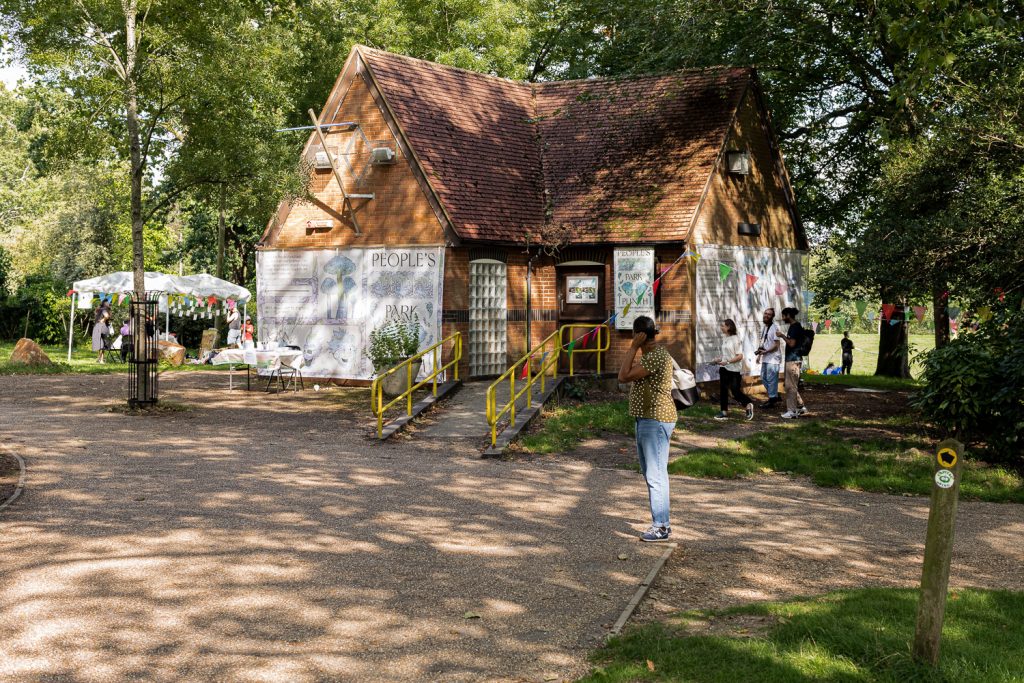
In 2019, we celebrated 150 years of Finsbury Park being the ‘People’s Park’ – a place where we can all do things together. In 2020 protests across the UK saw public artworks toppled from plinths, while the pandemic left us separated and isolated.
With this in mind, we launched the People’s Park Plinth this summer, as a way to re-explore our public spaces by turning Furtherfield Gallery inside out and expanding its digital arts programme beyond our walls and into the life of Finsbury Park.
We collaborated with incredibly talented artists, curators and local park members to create 3 ‘taster’ digital public artworks that speak about the park’s heritage and local stories. In May, June, and July we showcased a different digital art experience each month.
In August, the park made its pick! We will be launching a larger commission of Based on a Tree Story this Autumn, and to continue celebrating the heritage, artistry and local voices from Finsbury Park, all the ‘taster’ artworks will be available until January 2022.
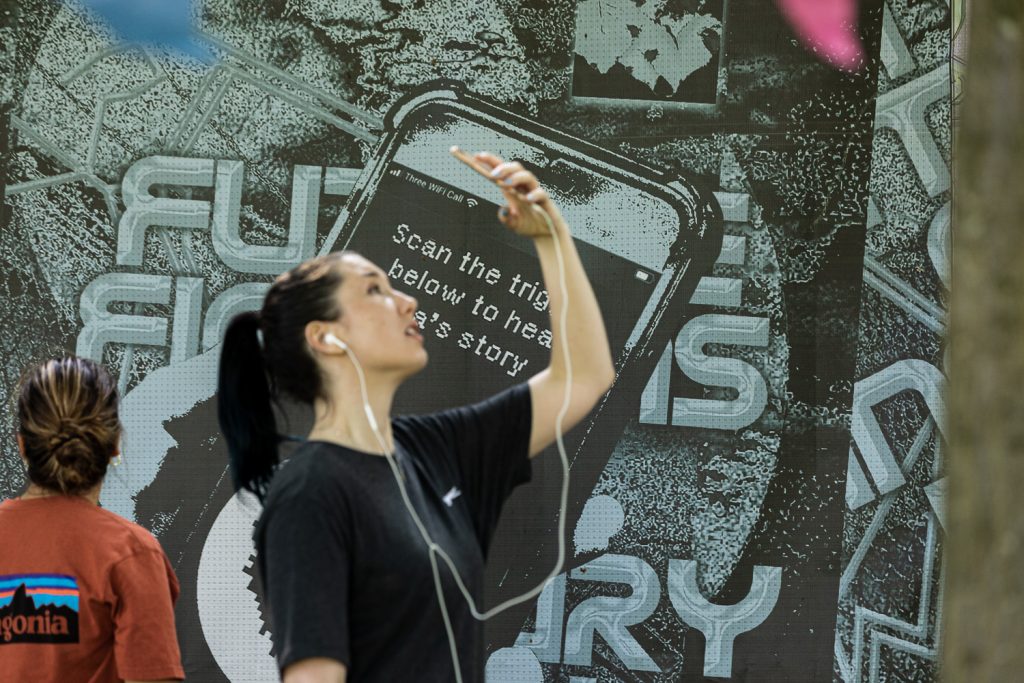
If you are in Finsbury Park you can use the camera on your phone to scan the QR codes on the People’s Park Plinth (presented on the exterior of our Gallery building in the centre of the park). They are all free to access, any time, with any smartphone – but you might want to have some headphones handy too.
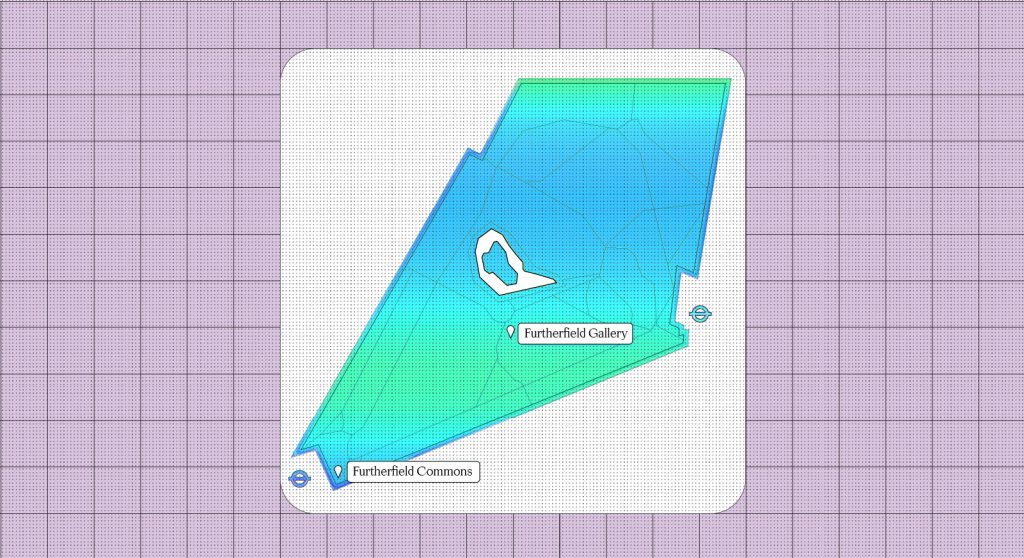
If you are somewhere else you can click the links on the People’s Park Plinth website to find the artworks.
It’s your park so it’s your pick!
Sign up here to get involved in choosing the artwork that most belongs in the heart of Finsbury Park next year.
Breath Mark x Lisa Hall & Hannah Kemp-Welch
Live until January 2022
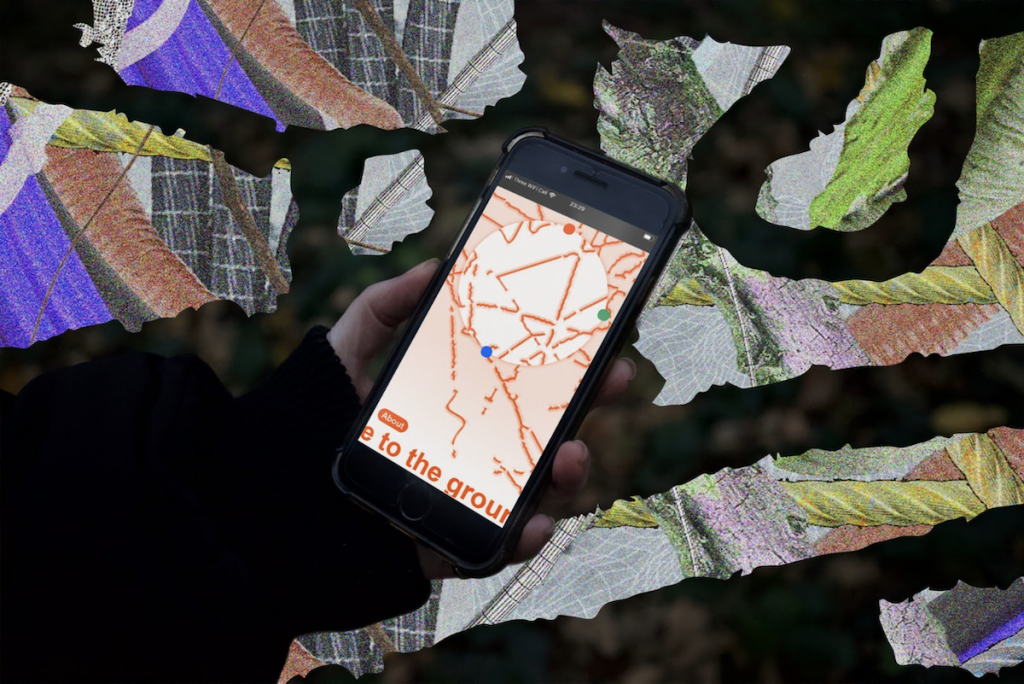
A site-specific, interactive sound work creating moments of connection between strangers of all species.
Follow this sound work as it leads you across the park to meeting points for animals, plants and strangers. As you listen, consider the needs of all these inhabitants and our symbiotic relationship that is increasingly under threat. Between heartbeats, vibrations and the alignment of crossing paths, this work sounds out a shared existence, putting these moments of connectivity with strangers of all species on the People’s Park’s Plinth.
The work features interviews with volunteers at Edible Landscapes, a forest gardening group based onsite at Finsbury Park: David Berrie, Imogen Simmonds, Jo Homan, Juliette Ezavin and Theo Betts. The artists were commissioned by Breath Mark, a curatorial collective formed as a part of the Royal College of Art’s MA Curating Contemporary Art Programme Graduate Projects 2021 in partnership with Furtherfield’s People’s Park Plinth project.
Taster: In this first iteration of the artwork, one sound pathway ‘Close to the ground’ is presented.
Larger commission: If this work had been selected in the public vote in August 2021, a further two sound pathways and a trail to find them would have been revealed.
HERVISIONS x Ayesha Tan Jones
Live until January 2022
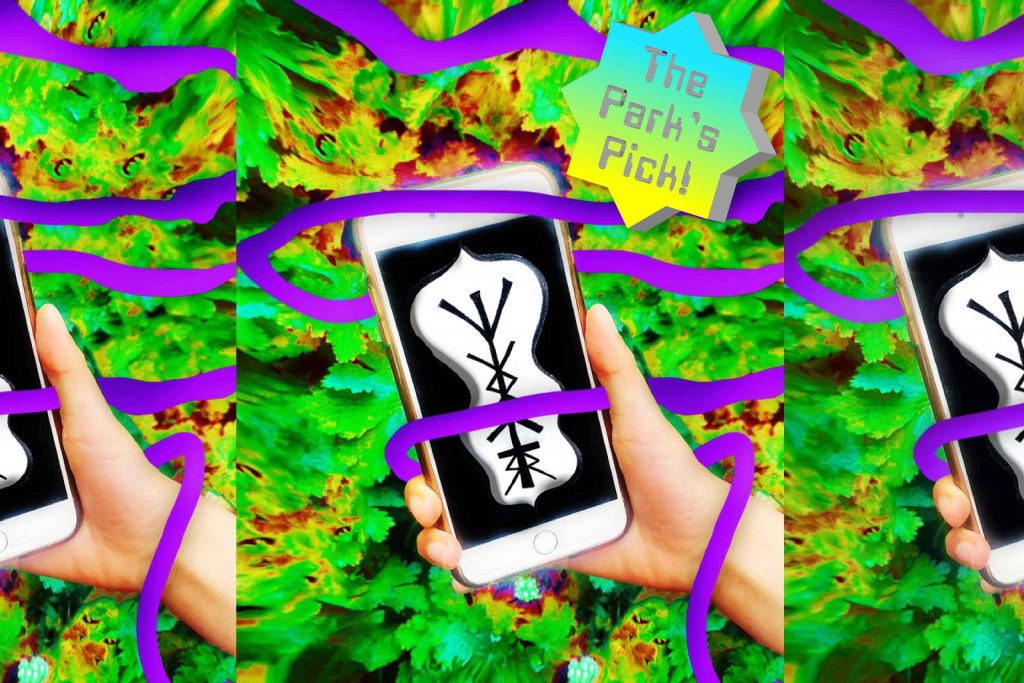
A site-specific, sonic augmented reality encounter with a digital tree sprite that tells tales of the tree’s past, present and future.
The trees of Finsbury Park are very old, and they have been witness to a lot of change and growth. If the trees had a voice, what would they share?
Based on a Tree Story brings to life Furtherfield Gallery’s nearby resident, a London plane tree dubbed the Trunk Triplets Tree, situated in Finsbury Park and the soils from which they grew, part of the now-extinct ancient woodland, Hornsey Woods. From medieval history to sci-fi futures, their stories are told through an augmented reality and audio experience, giving viewers an insight into the past, while arming them with inspiration and knowledge to help protect the trees into the future.
The project activates a digital tree sprite that shares a fable crafted through local research, site visits and discussion with Ricard Zanoli, the Park Ranger.
Taster: In this first iteration of the artwork one tree story is presented.
Larger commission: This work was selected in the public vote in August 2021 and further two tree stories and a trail of clues to find them will be revealed this Autumn.
Desree x Drumming School with Alex Dayo x Studio Hyte
Live until January 2022
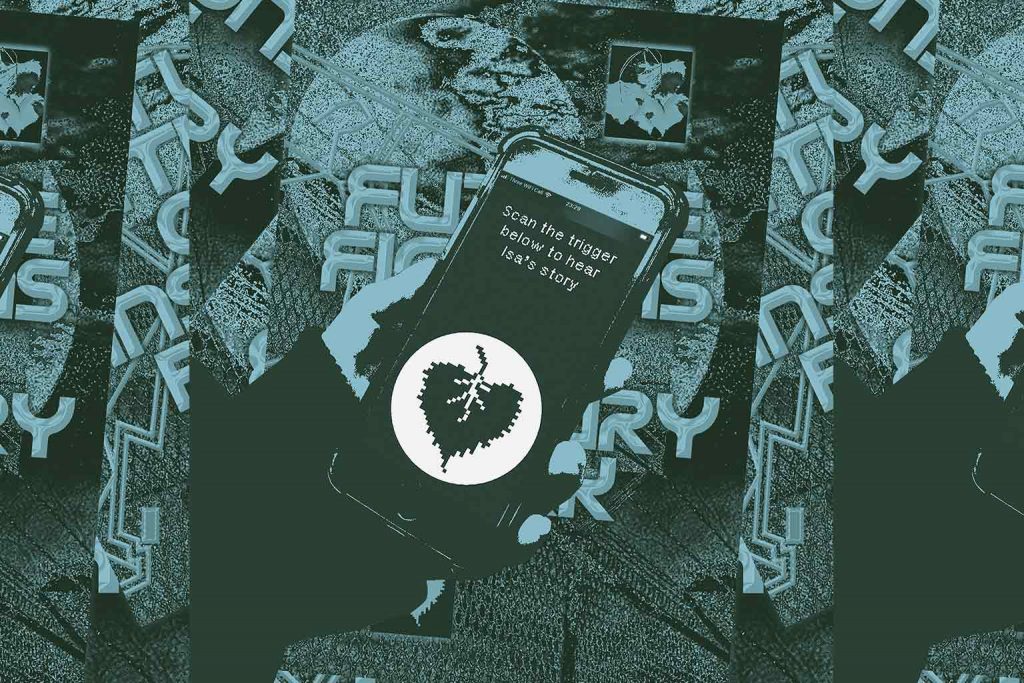
An augmented reality (AR) sci-fi zine comprising three stories that bring together writers, musicians, and local residents to explore alternative visions of a Finsbury Park of the future.
For this first iteration of the AR zine, released in July 2021 as part of the People’s Park Plinth programme, we present The Light and Dark: an audio-visual story about a fictional character, Isa, who wakes up in a home they don’t recognize, surrounded by land that feels as foreign as the sky they sit under. Isa does not know how they made it there, but they do know they have to make it home before the host finds them. With only the wisdom of Grandwa, and the feeling in their chest, Isa discovers the power of their historical connection to what was, their land.
The Light and Dark has been written by local spoken word artist and writer Desree, and is accompanied by a unique musical composition by musician Alex Dayo and his park-based Drumming School, in collaboration with David Kemp. The visual design, AR experience and animation have been developed by Studio Hyte.
Taster: In this first iteration of the artwork the start of one future fiction is presented.
Larger commission: Had this work been selected in the public vote in August 2021, this fiction would have been completed and two more would have been revealed.
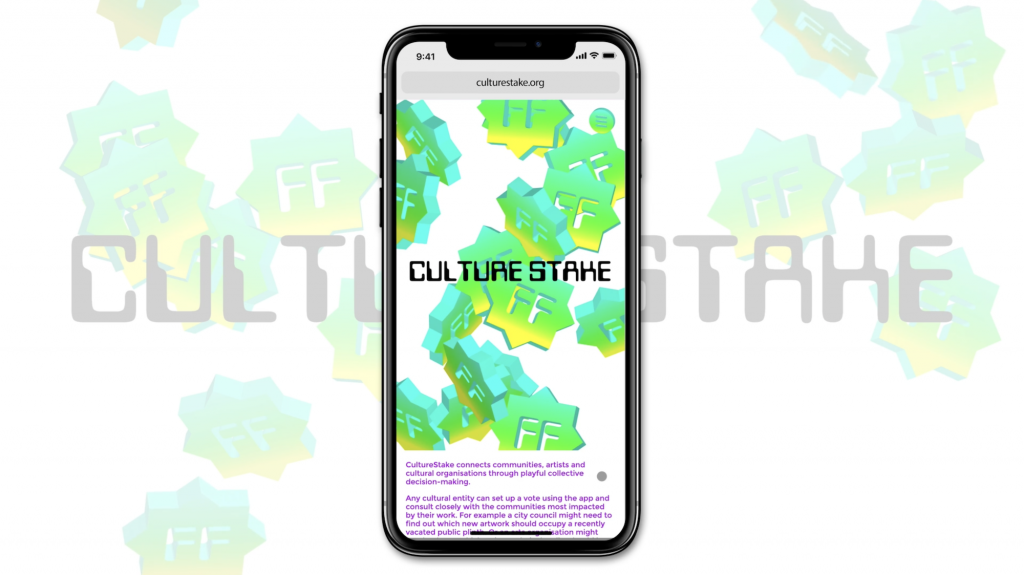
In August, after experiencing all 3 digital artworks, we asked people to pick which one they thought belonged in the heart of Finsbury Park by either:
Or
The park’s pick is Based on a Tree Story, and we are working with HERVISIONS and Ayesha Tan Jones to make a bigger and better version of their digital art experience – and then we will launch it on the People’s Park Plinth this Autumn!
We wanted everyone to express an opinion – even if visitors were far away what they felt mattered too. But if voters lived locally what they felt mattered more for the vote count – so we weighted the vote for anyone using the CultureStake app within or near the park.
If you are an arts organisation you can find out more about how you can use CultureStake to drive collective cultural decision-making at your own digital and physical events.
Breath Mark is a curatorial collective initiated as a part of the Curating Contemporary Art Graduate Projects Programme 2021, Royal College of Art. Comprising six international members, Breath Mark’s curatorial practice responds to the challenges of curating remotely and explores the interconnectivity of physical and digital site-specific experiences.
Members: Kevin Bello, Jindra Bucan, Harriet Min Zhang, Soyeon Park, Yifei Tang and Yuting Tang.
As part of extended public engagement, Breath Mark has collaborated with design studio An Endless Supply, on a digital microsite acting as a reading room allowing audiences to further engage with the artwork’s themes. We encourage visitors to extend their experiences through the texts, sounds and videos here: spaces.rca.ac.uk
Lisa Hall is a sound artist exploring how environments are built-in sound, while Hannah Kemp-Welch is a socially engaged artist concerned with listening. Hannah and Lisa met at London College of Communication while studying MA Sound Arts in 2010. They share an interest in public and private spaces, and how sound and audio technologies build networks and tell stories that often can’t be seen. They have collaborated on sound art projects for performances and installations at Tate Modern, CRiSAP, and Sound Reasons Festival: New Delhi.
https://www.sound-art-hannah.com
HERVISIONS is a femme-focussed curatorial agency supporting and promoting artists working across new and emergent technologies, and platforms with a strong focus on the intersection of art, technology and culture. HERVISIONS partner with institutes, organisations and galleries to create antidisciplinary exhibitions and innovative commissions. Select partners include, LUX, Tate, bitforms and Google Arts and Culture.
IG: @hervisions_
Ayesha Tan Jones AKA YaYa Bones work is a spiritual practice that seeks to present an alternative, queer, optimistic dystopia. They work through ritual, meditating through craft, dancing through the veil betwixt nature and the other. Ayesha weaves a mycelial web of diverse, eco-conscious narratives which aim to connect, enthral and induce audiences to think more sustainably and ethically. Traversing pop music, sculpture, alter-egos, digital image and video work, Ayesha sanctifies these mediums as tool’s in their craft. Selected recent commissions/exhibitions include: Shanghai Biennale (2021) Athens Biennale (2021) Solo Show at Underground Flower Offsite (2020) Serpentine Galleries, London (2019) IMT Gallery, London (2019) Mimosa House, London (2018), ICA, London (2018-2020) Cell Project Space, London (2018) Gropius Bau, Berlin (2018) Yorkshire Sculpture Park (2016-17). Ayesha is represented by Harlesden High Street Gallery, London.
https://www.ayeshatanjones.com/
Desree is an award-winning spoken word artist, writer and facilitator based in London and Slough. Currently Artist in Residence for poetry collective EMPOWORD, Desree explores intersectionality, justice and social commentary. Producer for both Word Up and Word Of Mouth, finalist in 2018’s Hammer & Tongue national final and TEDx speaker, she has featured at events around the UK and internationally, including Glastonbury Festival 2019, Royal Albert Hall and Bowery Poetry New York. Burning Eye Publishers republished Desree’s first pamphlet, I Find My Strength In Simple Things, in May 2021.
Alex Dayo comes from Burkina Faso where his professional musical career started in the 1980’s, accompanying the National Ballet Kouledafourou on tour as well as playing for African Royalty and globally recognised dignitaries at private and public events and the Ensemble des Radios and Televisions of Burkina Faso, based in Bobo-Dioulasso. In 1985, he founded Wountey, a collective of musicians who created a new fusion of traditional and modern music called Plenguedey, and, for fifteen years, toured across Africa and Europe, spreading Burkina Faso’s cultural fusion to a wider audience. His musical collaborations include Ali Farka Toure, Femi Kuti and Salif Keita from Africa and traditional Master Griots from Burkina Faso/Mali/Guinea/Gambia. An accomplished arranger, Alex incorporates African traditional, Fusion, Jazz, Rock, Latin and Caribbean influences. Alex moved to London in 2007, where he set up a drumming school. A highlight of Alex’s career was being chosen to play at the Opening and Closing ceremonies at the London 2012 Olympics.
http://drummingschool.co.uk/zantogola
DESIGN & DEVELOPMENT
Studio Hyte is an award-winning design studio, working between graphic design, interaction, and emergent communication. Their work includes branding, print, website, installation, and exhibition design. Specializing in forward-thinking, multifaceted visual identities within the arts and education sector. Whether through commissioned or self-directed projects, they aim to create meaningful, accessible, and thought-provoking work.
Formed of a small group of individual practitioners, Studio Hyte is the middle ground where all of our interests and practices meet. Their collective practice and research cover a broad spectrum of topics including language, inclusion & accessibility, egalitarian politics & alternative protest, and technology & the human.
IG: @studiohyte
#Carnivast (Windows and Android apps, 2012) Mez Breeze and Andy Campbell.
Behind the rollercoaster hype cycle of Virtual Reality (VR) over the last quarter of a century, artists have kept working with VR as an increasingly mature medium. Realtime interactive 3D computer graphics is the most visually immersive medium for illusion in art, and text is the most imaginatively immersive. Both have been used to create virtual reality, with 3D virtual worlds in the case of the former and text-based worlds such as MUDs, MUCKs and MOOs in the case of the latter. They might appear to clash but there is a long history of 3D VR that incorporates text into or as its spatial environment.

I reviewed Mez Breeze’s book “Human Readable Messages”, which collects Mez’s “Mezangelle” micro net.text artworks, for Furtherfield here and wrote:
Mezangelle surfaces and integrates the hidden aesthetics of computer mediated human activity, setting computing and human language in tension and synthesizing them. It expands the expressive possibilities of text and is a form of realism about the conditions in which human reading is currently flourishing. “Human Readable Messages” provides an ideal opportunity to familiarize ourselves with Mezangelle in the depth that it deserves and rewards.
Collected in book form, the ephemerally distributed but thoughtfully crafted code-like text of Mezangelle becomes a book of days. Placing the avowedly low-bandwidth textuality of Mezangelle into virtual space might seem perverse, but that is what the App “#Carnivast”, produced with Andy Campbell, does very successfully.
Launching #Carnivast displays a virtual world looking like the insides of a nebula rendered in cheesecloth, accompanied by a glitchy, breathy, echoey, wavey, phaser-y, stringy soundscape. Superimposed over this in white formal capital san-serif type is the hashtag title “#CARNIVAST”. To the top left of the screen are some small button controls. Warm autumnal evening motes of colour flicker slowly across the view as the virtual world rotates slowly giving a combined impression of immensity, solidity, weight, and atmosphere. The textures on the surfaces of the world (or that are the surfaces of the world) slide slowly over each other creating interference patterns.

It’s a sensuous world, although not entirely a comfortable one, and one that invites exploration of its depths, or at least a closer look at its surfaces. The motes and the breathing are reminiscent of Char Davis’ ambitious “Osmose” (1995), the aqualung-controlled immersive virtual forest environment.
Selecting a world from the buttons and exploring it by swiping and pinching shows that the texture of the surfaces of the virtual world is Mezangelle, undulating over and through the world in a way reminiscent of some of the scenes from Laurie Anderson’s interactive CD-ROM “Puppet Motel” (also 1995) or of Michael Takeo Magruder’s VRML visualizations. The finesse of the text and the undulating environment contrast with Jeffrey Shaw’s “Legible City” (1989), a virtual environment of larger-scale text, Barbara Kruger’s Futura gallery installations, or the jagged phosphor green glow of Neo’s view of the underlying code of reality in the Matrix.
#Carnivast is very much its own experience, a series of distinctive spaces to float in. The first and third world are curvilinear and warmly coloured, the first feels like the interior of a nebula or a tokamak, the third feels like the inside of a cell or an atom. The second world is rectilinear and more acidicly coloured, closest to traditional imaginings of cyberspace. They are all meditative spaces, somewhere to spend time outside of the everyday world and to reflect. Mezangelle is an unlikely construction material for such a space, it demands too much attention to be decorative and contains rough ASCII symbols that contrast with the smooth curves or rectilinear forms of each space. It exists in tension with the surfaces of the virtual worlds, and it is this that gives #Carnivast its conceptual energy.

If you’re unfamiliar with Mezangelle, the [] button switches the screen to a rotating carousel of panels of coloured Mezangelle text that you can swipe through. Mezangelle is personal expression in an impersonal style with a social context. The geometry of the virtual spaces of #Carnivast is a substitute for the latter, and it creates an unlikely but compelling allegorical visualization of the flow of Mezangelle through mailing lists and blogs. It is a model of the social and conversational Internet rather than its technological infrastructure.
#Carnivast is finely tuned to make a space that you can lose all sense of time and self in as you explore it. As well as running on Windows PCs it works well on different sizes of portable device (I tried it on a phone, on a small tablet and a 9 inch tablet), and would work well large-scale in a gallery. How I would love to see it is modified to work with the Oculus Rift, the new consumer stereo vision head-mounted display (HMD). A Rift-enabled #Carnivast would afford a less constant opportunity of escape than the mobile version, but would be even more immersive. It’s a shame that the software is proprietary (closed source), as otherwise the community could add that feature.

#Carnivast is a mature VR artwork that represents an immersive extension of the strategies of Mezangelle into an exploration of virtual and network space. Explore it in evenings at the desktop, or keep it on your phone and get away from commuter noise and crush whenever you need to. It is a meditative experience deepened through restraint in its choices of navigation and materials and through fine tuning of its aesthetics and experience.
The text of this review is licenced under the Creative Commons BY-SA 3.0 Licence.
Featured image: Environmental Risk Assessment Rover – ERAR – AT (2008) Mobile, Solar Powered, Networked Installation Off the Grid, Neuberger Mus
Refusing to regard technology merely as a tool, Ecoarttech expand the uses of mobile technology and digital networks revealing them to be fundamental components of the way we experience our environment. Their most recent work Indeterminate Hikes + (IH +) is a phone app that maps a series of trails through the city. IH + can be accessed globally, or wherever users have access to Google Maps on their mobile phones. After identifying the users’ location, IH + generates a route along random “Scenic Vistas” within urban spaces. Users are directed to perform a series of tasks along the trail and provide feedback in the form of snapshots generating an ongoing, open-ended dialogue.
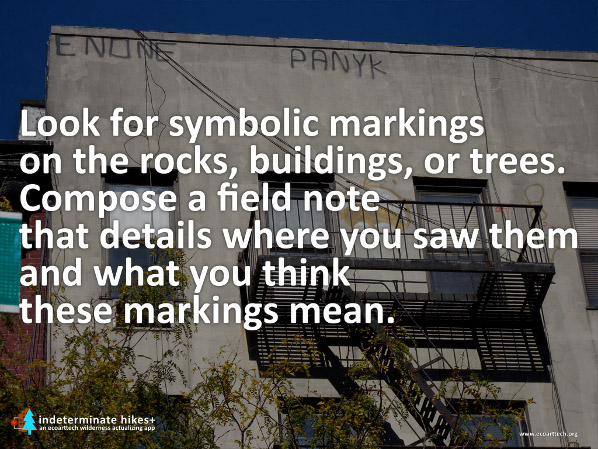
But the experience of their work is primarily an encounter with technology. Since 2005, Leila Nadir and Cary Peppermint of Ecoarttech have been engaged in an artistic exploration of environmental sustainability and convergent media. By drawing our attention to the increasing replacement or mediation of physical experiences by technology, Ecoarttech challenge the widely reproduced distinction between nature and culture. They present their work in the form of videos, digital networks, blogs, performance and installations. Their early video-based work (Wilderness Trouble and Frontier Mythology) plays out a performative and ironic encounter with the natural environment as a historically constructed concept. In the summer of 2005 Ecoarttech made A Series of Practical Performances in the Wilderness (2005) a database networked performance in QuickTime (DVD and Podcast). The short clips document what Ecoarttech ironically describe as “the experiences of two New Yorkers embarking on their first four months in the woods“. Their objectives were nothing short of
…establishing a functional home without running water, electricity, or maintained roads; developing relationships with locals; un-learning the romanticization of nature while re-learning humanity’s dependence on the environment for survival; and researching the details of the history of the land and the surrounding area.
Sophia Kosmaoglou: The confrontation with the concept of “wilderness” appears to motivate much of your work to date. How did A Series of Practical Performances in the Wilderness begin and how did you fare?
Leila Nadir and Cary Peppermint: About eight years ago, we were very fortunate to acquire a primitive cabin on 50 acres of wild, wooded land, and the experiences we had there changed us completely. Each time we drove from NYC to our “camp” as the locals called it, we were immobilized for about 3-4 days, hardly able to move our bodies as our nervous systems screeched to a halt, adjusting to the quiet. We found a freedom in the woods that we couldn’t find the city – the freedom to take up space, to play, to be quiet, slow, and still. We were also amazed by how some people in the country could seemingly live more independently from bloated global economic systems, growing their own food, chopping their own fuel, harvesting solar energy. They interacted directly with the natural environment whereas we had spent our entire lives ecologically infantilized by overdependence on the industrial grid. We began spending several months at a time at our cabin in the woods: A Series of Practical Performances in the Wilderness is a document of our environmental adventures at that time. It was our first attempt at making art in remote, wilderness spaces. It was a sort of performance of ecological/cultural collision.
SK: How did this experience inform your subsequent work?
LN & CP: As we began to study environmental theory, we realized that not only does little “true” wilderness actually exist, the myth of wilderness was used to obscure the history of indigenous people living on the North American continent. Our own land, we learned, had once been a pasture and had been logged numerous times. Coming to terms with the fact that we hadn’t really retreating to “nature” was the focus of our video Wilderness Trouble which attempts to imagine a new kind of environmental ethics that includes urban and electronic spaces and modern networked culture. However, we still believe that wilderness provides a lot of imaginative potential. Amazement at sublime landscapes can provoke an emotional response that can be politically motivating, and we have tried to take advantage of that potential in our smartphone app Indeterminate Hikes +. By importing the rhetoric of wilderness into everyday life through Google-mapped hiking trails, the app attempts to inspire a sense of ecological wonder at usually disregarded spaces, such as city sidewalks, alleyways, and apartment buildings. We wanted to see what would happen if a walk down a sidewalk were treated as a wilderness excursion. What if we consider the water dripping off an air-conditioner with the same attention that we give a spectacular waterfall in the wilderness?
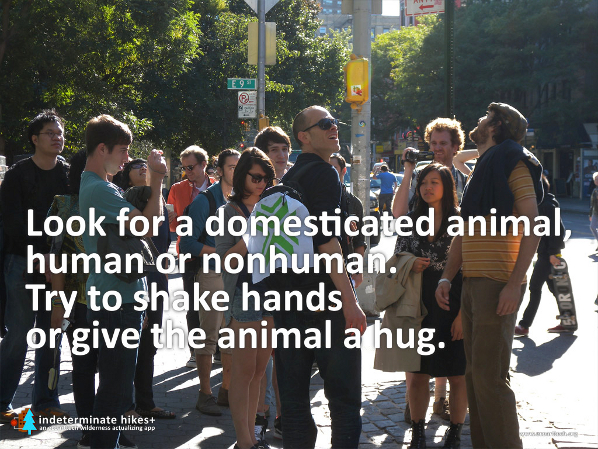
SK: There is a recurring effort in your work to question the opposition between environment and technology, which is usually accompanied by an ironic undercurrent in your narration and editing that acknowledges what you call “cultural collision”. In Google is a National Park and Nature is a Search Engine which is also part of a series of performances called Center for Wildness in the Everyday (2010), itself conceived as an ecosystem, you suggest that an “environment” is a network of relationships common to natural as well as technological systems, whether it is the ecosystem of a river estuary or Google. Do you see this as a sustainable analogy or a productive contradiction?
LN & CP: Part of what we find frustrating about a lot of environmental thought is that it either wholly rejects technology as the cause of ecological crises so our only solution is to go primitive or wholly embraces technological progress as a saviour, which often means we have to trust in corporate and scientific innovation to lead the way. We think there is another way. We see humans as essentially technical beings: human-animals literally cannot survive without technics. The U.S. military survival guide comes right out and admits that your situation is pretty hopeless if you are stranded in the wilderness without at least a knife. If technology is part of who we are – and we find Bernard Stiegler’s work helpful for thinking this through – then we have also evolved with technology. We are not the same sorts of humans as, for example, Leila’s great-grandmothers in Slovakia or Afghanistan a century ago. The question, then, is not, Yes or No to Technology, but rather, How do we engage technology sustainably and in a way that supports creativity and freedom? And if human beings are technical beings, relying on nature and culture simultaneously, is it even possible to distinguish between what’s natural and what’s not? Isn’t our sustenance dependent upon not only our biological needs (clean air, water and food) but also our cultural practices, beliefs, and imagination? This is why we find it essential to think about electronic spaces and digital technologies whenever we think about the “environment.”
The installation called Google is a National Park and Nature is a Search Engine, a work that is part of a series of performances called Center for Wildness in the Everyday commissioned by the University of North Texas. Our task for this commission was to create a networked artwork about the Trinity River Basin, the source of water for the Dallas/Fort Worth metroplex. In the image, the Trinity River looks like a space of natural refuge but the scientists we worked with there explained that the River’s flow is guaranteed only by the recycling of waste water at treatment plants. We wanted to create a work that juxtaposed this hidden constructedness of “nature” with the more obvious man-made Google – two processes or entities that we rely on everyday for our ecological sustenance: water management and online information.
SK: In 2008, you made the Environmental Risk Assessment Rover, a solar-powered module, which gathers and projects information regarding threats in the immediate environment. Although the ERAR is a sizeable aggregate of equipment that is carted around in a wagon, it seems to be the precursor to handy mobile phone apps. How does the ERAR work?
LN & CP: This project is part of our ongoing engagement with science – especially environmental science, which is also a focus of our 2009 work Eclipse. When you work at the crossroads of art and science, as we do, there is often an assumption that the role of the arts in this interdisciplinary exchange is to visualize or communicate knowledge produced by scientists. In contrast, ERAR asks what we learn when science breaks down – or when we use science to “interrupt” experience rather than to predict behaviours. The project arose out of our observations of the U.S. Department of Homeland Security’s handy yet arguably useless colour-coded terror alert system launched post 9/11 and our experiences with what risk theorist Ulrich Beck calls “science’s monopoly on truth”. Somewhere Beck writes that cows can turn blue next to a chemical plant, but unless science actually proves that the chemicals are the cause of the blue, nothing will be done about the situation. So although other forms of knowing might tell us that the plant is a public health risk, there is nothing we can do until Science “proves” a direct causal relationship. The Rover collects real-time risk data relative to its GPS coordinates, such as car or subway accidents, air pollution levels, violent crimes, proximity of superfund sites, and ground water toxicity, and then determines the aggregate local threat level through a 14-tiered alert system, ranging from “Holiday Shopping” and “Plastic Bags” to “Girls Gone Wild” and “Ask Your Doctor”. Obviously there is a bit of Dada in this work – but not Dada as simple chaos, as it is popularly invoked, but rather Dada as a shocking exposure of the limits of modern reason at the same time as it brings to the surface something that many of us have repressed from consciousness: the subliminal knowledge that there are ways of knowing the world that come from non-scientific experiences and observations. This tension between scientific expertise and everyday experience is also at play in our recent work #TrainingYRHuman.
SK: Have you considered launching it as a phone app?
LN & CP: The ERAR was our first truly mobile work, and it would probably make an interesting phone app – however, the public spectacle it creates is integral to the effectiveness of the work. Pulling around a wagon of technological parts that beams alerts onto the side of buildings is an art action and an effective conversation starter.
SK: Social networks and mobile phone app technology have rapidly become established means of communication and art galleries currently employ these technologies conventionally to replace audio guides. Your current work explores social networks and phone apps as potentially innovative platforms for art. Indeterminate Hikes + (2012) and #TrainingYRHuman (2011) can be accessed in diverse contexts and within everyday activities. They address a broad public, providing a plurality of entry points without necessarily being identified as art. How has the public responded to these projects so far and how do you hope to see them pan out in the long-term?
LN & CP: What motivates us most about working with new technologies is how they can be misused for unexpected purposes. Smartphones, generally, are deployed as devices of rapid communication and consumerism, to get you what you want and where you want as quickly as possible. Our app Indeterminate Hikes + reappropriates this mobile technology for a very different end, turning smartphones into tools of environmental imagination and meditative wonder. It transforms ubiquitous computing into an opportunity to notice the happenings occurring all around us in our local environments, to see sublimity in our backyards, alleyways, streets and neighbourhoods. Like many of our works, this is also a way to aesthetically pose an alternative to environmentalism’s frequent anti-media stance and to popular culture’s uncritical embrace of technology. We want to dream new ways of being without falling into prescribed behaviours or reactionary responses, whether with the food we eat, the technologies we interact with, or the environmental relations we imagine. Foucault’s call for the creation of “gay style” as an antidote to heteronormative culture has always resonated with us in our attempts to rethink dominant ways of being: what is the space of freedom in which one can intervene and express oneself, invent, upend? The mood after our public indeterminate hikes is often euphoric, and participant-hikers comment that they see the world anew. If enabled to be, smartphones can be a platform for chance operations, which, as Allen Kaprow explained, can create “near-miracles”: “when something goes ‘wrong,’ something far more ‘right,’ more revelatory, has many times emerged”. Our app can be used anywhere, any time, by anyone who has an Android phone or who attends our performances, so hopefully there will be many people misusing their smartphones and taking wilderness hikes in the wrong places for a long time. An iPhone version will be released this spring/summer 2012.

#TrainingYRHuman, a work-in-progress, is a participatory Twitter-based net artwork about the agency of animals who live with human-animals as well as an attempt to speak back to science’s monopoly on truth. In recent years, a burst of scientific research has illuminated animals’ behaviours, ethical attitudes, modes of cognition, and psychological awareness, yet usually when we read news of this work, we think: Were all those scientific tests really necessary to figure out that a certain animal species has feelings? Many people who work and live closely with animals already had abundant anecdotal evidence to support the fact that nonhuman animals have diverse personalities and creative problem-solving skills, that they think, feel, and are conscious. #TrainingYRHuman is a gesture toward bringing those anecdotes into the public record, toward creating a sort of oral history database of animal-agency stories that usually only circulate subliminally in our informal conversations. At the same time, it is a moment for human-Tweeters to imagine what it’s like to be a nonhuman animal, inventing unique ways to express oneself and meet one’s needs and desires in a human-dominated world.
SK: There are multiple registers and modes of address in your work and an ambiguity regarding the speaking subject. To an extent, this is because there are two of you, but you also construct voices and use various techniques to create further ambiguity around your agency. Can you elaborate on your strategies of collaboration and decision-making and how these relate to the tension and displacement that you create between the cultural and the technological, the physical and the digital, the artistic and the scientific, the collective and the individual?
LN & CP: Our primary collaborators are each other. Though we have a division of labour, we don’t have a conscious strategy of how we work conceptually, perhaps because we fell into making art together organically, out of collaborating on life. Ideas emerge for us out of an ongoing, sometimes unconscious, sometimes over-analytical, conversation that meanders through the digital/physical places we inhabit, whether we are in our studio or the kitchen. Whose idea it was to add orange juice to our hummus recipe or who came up with facilitating alter-wilderness hikes via smartphones is impossible to figure out. We are committed to an experimentality in process that involves interaction, exchange, exposure, and research that can take advantage of the energy created by blurring the lines between self and other. Proprietary works and the myth of the “genius” artist are detrimental to emerging modes of working, especially with regard to new media art production. Lately, animals have been a significant part of this process for us, shaking up our stale human behaviours and assumptions, especially the cows, sheep, and pigs we visited recently at the Farm Sanctuary in Watkins Glen, NYState, and the birds of prey we met through a local bird sanctuary called Friends with Feathers.
We can’t really say with authority whether our extended collaboration relates to the ambiguities of our artworks. However, we do try to welcome the breakdown of categories like digital, physical, human, nature, and animal as well as media, disciplinary, and environmental boundaries. What really is a “human”, and why has there been this historical obsession with somehow distinguishing humans from animals, as if we are somehow specially different from every other animate being on earth, more evolved and complex? As eco-critic Timothy Morton said recently, “According to evolution science, there are two things humans do very well, but they are a bit of an ego blow: throwing and sweating. Everything else is also done by nonhumans, including consciousness, feelings, art, tool use”. So we are simply sweaty throwers who think very highly of ourselves! It seems to us that the effort to hold tight to definitions, to reliable knowledge, or to the self blocks the more interesting conflations that happen (or are already happening) when we let categories slip away. Therefore, rather than try to determine, define, and predict in our art, we are more interested in staging fluid experiences that ask difficult questions and interrupt our sense of certainty. When assumptions fail, things fall apart, and we can’t depend on what we think we know, that is when our most creative thinking takes place. These are exciting, experimental moments.
Leila Nadir and Cary Peppermint founded Ecoarttech in 2005. They teach Video Art and Sustainability Studies at the University of Rochester in New York and they work with a range of institutions, including the Whitney Museum, Turbulence.org and the University of North Texas. They have exhibited at MIT Media Lab, Smackmellon Gallery, European Media Art Festival, Exit Art Gallery and the Neuberger Museum of Art. In June 2012, they will be artists in residence at Joya: Arte+Ecología, an off-the-grid residency program based at Cortijada Los Gázquez in Parque Natural Sierra Maria-Los Velez in Eastern Andalucía.